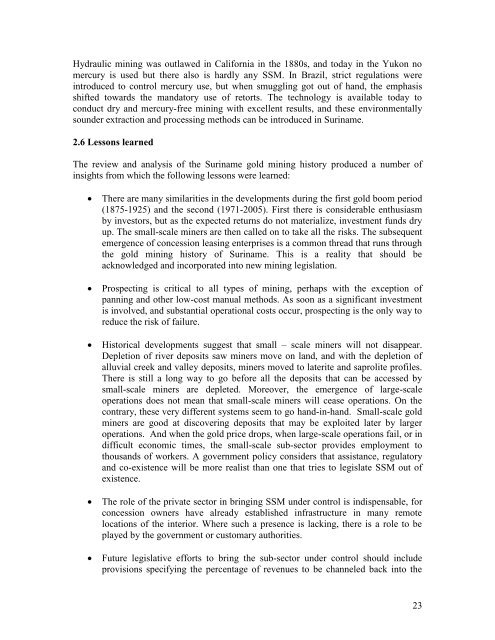SITUATION ANALYSIS OF THE SMALL-SCALE GOLD ... - WWF
SITUATION ANALYSIS OF THE SMALL-SCALE GOLD ... - WWF
SITUATION ANALYSIS OF THE SMALL-SCALE GOLD ... - WWF
You also want an ePaper? Increase the reach of your titles
YUMPU automatically turns print PDFs into web optimized ePapers that Google loves.
Hydraulic mining was outlawed in California in the 1880s, and today in the Yukon no<br />
mercury is used but there also is hardly any SSM. In Brazil, strict regulations were<br />
introduced to control mercury use, but when smuggling got out of hand, the emphasis<br />
shifted towards the mandatory use of retorts. The technology is available today to<br />
conduct dry and mercury-free mining with excellent results, and these environmentally<br />
sounder extraction and processing methods can be introduced in Suriname.<br />
2.6 Lessons learned<br />
The review and analysis of the Suriname gold mining history produced a number of<br />
insights from which the following lessons were learned:<br />
There are many similarities in the developments during the first gold boom period<br />
(1875-1925) and the second (1971-2005). First there is considerable enthusiasm<br />
by investors, but as the expected returns do not materialize, investment funds dry<br />
up. The small-scale miners are then called on to take all the risks. The subsequent<br />
emergence of concession leasing enterprises is a common thread that runs through<br />
the gold mining history of Suriname. This is a reality that should be<br />
acknowledged and incorporated into new mining legislation.<br />
Prospecting is critical to all types of mining, perhaps with the exception of<br />
panning and other low-cost manual methods. As soon as a significant investment<br />
is involved, and substantial operational costs occur, prospecting is the only way to<br />
reduce the risk of failure.<br />
Historical developments suggest that small – scale miners will not disappear.<br />
Depletion of river deposits saw miners move on land, and with the depletion of<br />
alluvial creek and valley deposits, miners moved to laterite and saprolite profiles.<br />
There is still a long way to go before all the deposits that can be accessed by<br />
small-scale miners are depleted. Moreover, the emergence of large-scale<br />
operations does not mean that small-scale miners will cease operations. On the<br />
contrary, these very different systems seem to go hand-in-hand. Small-scale gold<br />
miners are good at discovering deposits that may be exploited later by larger<br />
operations. And when the gold price drops, when large-scale operations fail, or in<br />
difficult economic times, the small-scale sub-sector provides employment to<br />
thousands of workers. A government policy considers that assistance, regulatory<br />
and co-existence will be more realist than one that tries to legislate SSM out of<br />
existence.<br />
The role of the private sector in bringing SSM under control is indispensable, for<br />
concession owners have already established infrastructure in many remote<br />
locations of the interior. Where such a presence is lacking, there is a role to be<br />
played by the government or customary authorities.<br />
Future legislative efforts to bring the sub-sector under control should include<br />
provisions specifying the percentage of revenues to be channeled back into the<br />
23
















